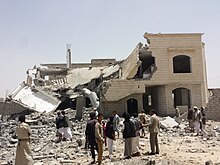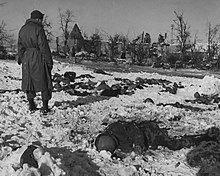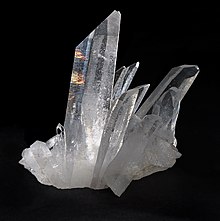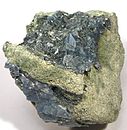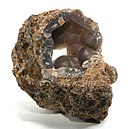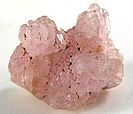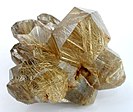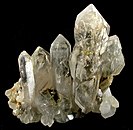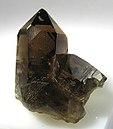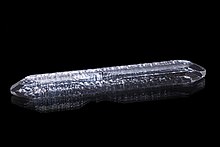A picture taken by the Polish Underground of Nazi Secret Police rounding up Polish intelligentsia at Palmiry near Warsaw in 1940 for mass execution (German AB-Aktion in occupied Poland).
A war crime is an act that constitutes a serious violation of the laws of war that gives rise to individual criminal responsibility. Examples of war crimes include intentionally killing civilians or prisoners, torturing, destroying civilian property, taking hostages, performing a perfidy, raping, using child soldiers, pillaging, declaring that no quarter will be given, and seriously violating the principles of distinction and proportionality, and military necessity.
The concept of war crimes emerged at the turn of the twentieth century when the body of customary international law applicable to warfare between sovereign states was codified. Such codification occurred at the national level, such as with the publication of the Lieber Code in the United States, and at the international level with the adoption of the treaties during the Hague Conventions of 1899 and 1907. Moreover, trials in national courts during this period further helped clarify the law. Following the end of World War II, major developments in the law occurred. Numerous trials of Axis war criminals established the Nuremberg principles, such as notion that war crimes constituted crimes defined by international law. Additionally, the Geneva Conventions in 1949 defined new war crimes and established that states could exercise universal jurisdiction over such crimes. In the late 20th century and early 21st century, following the creation of several international courts, additional categories of war crimes applicable to armed conflicts other than those between states, such as civil wars, were defined.
History
Suzhou, China, 1938. A ditch full of the bodies of Chinese civilians, killed by Japanese soldiers.
Early examples
The trial of Peter von Hagenbach by an ad hoc tribunal of the Holy Roman Empire in 1474 was the first "international" war crimes trial, and also of command responsibility.
He was convicted and beheaded for crimes that "he as a knight was
deemed to have a duty to prevent", although he had argued that he was
"just following orders"
In 1865, Henry Wirz, a Confederate States Army officer, was held accountable by a military tribunal and hanged for the appalling conditions at Andersonville Prison, where many Union prisoners of war died during the American Civil War.
Hague Conventions
The Hague Conventions were international treaties negotiated at the First and Second Peace Conferences at The Hague,
Netherlands, in 1899 and 1907, respectively, and were, along with the
Geneva Conventions, among the first formal statements of the laws of war and war crimes in the nascent body of secular international law.
Geneva Conventions
The Geneva Conventions
are four related treaties adopted and continuously expanded from 1864
to 1949 that represent a legal basis and framework for the conduct of
war under international law. Every single member state of the United
Nations has currently ratified the conventions, which are universally
accepted as customary international law,
applicable to every situation of armed conflict in the world. However,
the Additional Protocols to the Geneva Conventions adopted in 1977
containing the most pertinent, detailed and comprehensive protections of
international humanitarian law
for persons and objects in modern warfare are still not ratified by a
number of States continuously engaged in armed conflicts, namely the
United States, Israel, India, Pakistan, Iraq, Iran, and others.
Accordingly, states retain different codes and values with regard to
wartime conduct. Some signatories have routinely violated the Geneva
Conventions in a way which either uses the ambiguities of law or
political maneuvering to sidestep the laws' formalities and principles.
Three conventions were revised and expanded with the fourth one added in 1949:
- First Geneva Convention for the Amelioration of the Condition of the Wounded and Sick in Armed Forces in the Field (Convention for the Amelioration of the Condition of the Wounded and Sick in Armed Forces in the Field was adopted in 1864, significantly revised and replaced by the 1906 version, the 1929 version, and later the First Geneva Convention of 1949).
- Second Geneva Convention for the Amelioration of the Condition of Wounded, Sick and Shipwrecked Members of Armed Forces at Sea (Convention for the Amelioration of the Condition of Wounded, Sick and Shipwrecked Members of Armed Forces at Sea was adopted in 1906, significantly revised and replaced by the Second Geneva Convention of 1949).
- Third Geneva Convention relative to the Treatment of Prisoners of War (Convention relative to the Treatment of Prisoners of War was adopted in 1929, significantly revised and replaced by the Third Geneva Convention of 1949).
- HRW wrote that the Saudi Arabian-led military intervention in Yemen that began on March 26, 2015 had conducted airstrikes in apparent violation of the laws of war.
- Fourth Geneva Convention relative to the Protection of Civilian Persons in Time of War (first adopted in 1949, based on parts of the 1907 Hague Convention IV).
Two Additional Protocols were adopted in 1977 with the third one added in 2005, completing and updating the Geneva Conventions:
- Protocol I (1977) relating to the Protection of Victims of International Armed Conflicts.
- Protocol II (1977) relating to the Protection of Victims of Non-International Armed Conflicts.
- Protocol III (2005) relating to the Adoption of an Additional Distinctive Emblem.
Leipzig War Crimes Trial
A small number of German military personnel of the First World War were tried in 1921 by the German Supreme Court for alleged war crimes.
London Charter / Nuremberg Trials 1945
The modern concept of war crime was further developed under the auspices of the Nuremberg Trials based on the definition in the London Charter that was published on August 8, 1945. (Also see Nuremberg Principles.)
Along with war crimes the charter also defined crimes against peace and
crimes against humanity, which are often committed during wars and in
concert with war crimes.
International Military Tribunal for the Far East 1946
Also known as the Tokyo Trial, the Tokyo War Crimes Tribunal or
simply as the Tribunal, it was convened on May 3, 1946 to try the
leaders of the Empire of Japan for three types of crimes: "Class A"
(crimes against peace), "Class B" (war crimes), and "Class C" (crimes
against humanity), committed during World War II.
International Criminal Court 2002
Bodies of some of the hundreds of Vietnamese villagers who were killed by U.S. soldiers during the My Lai Massacre.
On July 1, 2002, the International Criminal Court, a treaty-based court located in The Hague,
came into being for the prosecution of war crimes committed on or after
that date. Several nations, most notably the United States, China,
Russia, and Israel, have criticized the court. The United States still
participates as an observer. Article 12 of the Rome Statute provides
jurisdiction over the citizens of non-contracting states in the event
that they are accused of committing crimes in the territory of one of
the state parties.
- Grave breaches of the Geneva Conventions, such as:
- Willful killing, or causing great suffering or serious injury to body or health
- Torture or inhumane treatment
- Unlawful wanton destruction or appropriation of property
- Forcing a prisoner of war to serve in the forces of a hostile power
- Depriving a prisoner of war of a fair trial
- Unlawful deportation, confinement or transfer
- Taking hostages
- Directing attacks against civilians
- Murder, cruel or degrading treatment and torture
- Directing attacks against civilians, humanitarian workers or UN peacekeepers
- Civilians killed in shelling in eastern Ukraine. According to the HRW report, "The use of indiscriminate rockets in populated areas violates international humanitarian law, or the laws of war, and may amount to war crimes."
- Taking hostages
- Summary execution
- Pillage
- Rape, sexual slavery, forced prostitution or forced pregnancy
Prominent indictees
Heads of state and government
Sudanese President Omar al-Bashir, wanted by the ICC for war crimes and crimes against humanity.
- German Großadmiral and President Karl Dönitz and Japanese Prime Ministers and Generals Hideki Tōjō and Kuniaki Koiso in the aftermath of World War II.
- Former Serbian President Slobodan Milošević was brought to trial charges with, genocide, crimes against humanity, and war crimes in three republics. The tribunal found the prosecution had according to its rules and procedures; enough evidence was tailored, prior to the defense presentation, that, "a reasonable trier of fact, could conclude, the accused was responsible for the crimes charged." This pertaining to superior responsibility, for the Bosnia and Croatia indictment's, and individual responsibility, for the Kosovo indictment. No conviction was established however, as he died in custody in 2006, before the trial could be concluded.
- Former Liberian President Charles G. Taylor was also brought to The Hague charged with war crimes; his trial stretched from 2007 to March 2011. He was convicted in April 2012 of Aiding and Abbetting and planning the commission of Crimes against Humanity, committed during the war under individual and command responsibility.
- Former Bosnian Serb President Radovan Karadžić was arrested in Belgrade on July 18, 2008 and brought before Belgrade's War Crimes Court a few days after. He was extradited to the Netherlands, and is currently in The Hague, in the custody of the International Criminal Tribunal for the former Yugoslavia. The trial began in 2010. On March 24, 2016, he was found guilty of genocide in Srebrenica, war crimes and crimes against humanity, 10 of the 11 charges in total, and sentenced to 40 years' imprisonment. He was sentenced to life on appeal.
- Omar al-Bashir, former head of state of Sudan, is charged with three counts of genocide, crimes against humanity and other war crimes regarding the 2003– War in the Darfur region of Sudan. The first head of state charged with genocide by the International Criminal Court with current warrants of arrest actions in Darfur.
- 2013 Shahbag protests demanding the death penalty for the war criminals of the 1971 Bangladesh Liberation War
- Former Libyan leader Muammar Gaddafi was indicted for allegedly ordering the killings of protesters and civilians and Crimes against Humanity, during the 2011 Libyan civil war, however he was killed before he could stand trial in October 2011.
Other prominent indictees
- Yoshijirō Umezu, a general in the Imperial Japanese Army
- Seishirō Itagaki, War minister of the Empire of Japan
- Hermann Göring, Commander in Chief of the Luftwaffe.
- Ernst Kaltenbrunner and Adolf Eichmann, high-ranking members of the SS.
- Wilhelm Keitel, Generalfeldmarschall, head of the Oberkommando der Wehrmacht.
- Erich Raeder, Großadmiral, Commander in Chief of the Kriegsmarine.
- Albert Speer, Minister of Armaments and War Production in Nazi Germany 1942–45.
- William Calley, former U.S. Army officer found guilty of murder for his role in the My Lai Massacre
- Ali Hassan Abd al-Majid al-Tikriti, more commonly known by his nickname "Chemical Ali", executed by post-Ba'athist Iraq for his leadership of the gassing of Kurdish villages during the Iran-Iraq War; also governor of illegally occupied Kuwait during the First Gulf War
- Ratko Mladić, indicted for genocide amongst other violations of humanitarian law during the Bosnian War; he was captured in Serbia in May 2011 and was extradited to face trial in The Hague, wherin he was found guilty and sentenced to life in prison.
- Joseph Kony, leader of the Lord's Resistance Army, guerrilla group which used to operate in Uganda.
Definition
Aftermath of the Malmedy massacre (1944).
The rule of war, also known as the Law of Armed Conflict, permit belligerents to engage in combat. A war crime occurs when superfluous injury or unnecessary suffering is inflicted upon an enemy.
War crimes also include such acts as mistreatment of prisoners of war or civilians. War crimes are sometimes part of instances of mass murder and genocide though these crimes are more broadly covered under international humanitarian law described as crimes against humanity. In 2008, the U.N. Security Council adopted Resolution 1820, which noted that "rape and other forms of sexual violence can constitute war crimes, crimes against humanity or a constitutive act with respect to genocide"; see also war rape. In 2016, the International Criminal Court convicted someone of sexual violence for the first time; specifically, they added rape to a war crimes conviction of Congo Vice President Jean-Pierre Bemba Gombo.
Mass grave of Soviet POWs, killed by Germans. Some 3.3 million Soviet POWs died in Nazi custody.
War crimes are significant in international humanitarian law because it is an area where international tribunals such as the Nuremberg Trials and Tokyo Trials have been convened. Recent examples are the International Criminal Tribunal for the Former Yugoslavia and the International Criminal Tribunal for Rwanda, which were established by the UN Security Council acting under Chapter VIII of the UN Charter.
Under the Nuremberg Principles, war crimes are different from crimes against peace. Crimes against peace include planning, preparing, initiating, or waging a war of aggression, or a war in violation of international treaties, agreements, or assurances. Because the definition of a state of "war" may be debated, the term "war crime" itself has seen different usage under different systems of international and military law. It has some degree of application outside of what some may consider to be a state of "war", but in areas where conflicts persist enough to constitute social instability.
The legalities of war have sometimes been accused of containing favoritism toward the winners ("Victor's justice"), as some controversies have not been ruled as war crimes. Some examples include the Allies' destruction of Axis cities during World War II, such as the firebombing of Dresden, the Operation Meetinghouse raid on Tokyo (the most destructive single bombing raid in history), and the atomic bombings of Hiroshima and Nagasaki. In regard to the strategic bombing during World War II, there was no international treaty or instrument protecting a civilian population specifically from attack by aircraft, therefore the aerial attacks on civilians were not officially war crimes. The Allies at the trials in Nuremberg and Tokyo never prosecuted the Germans, including Luftwaffe commander-in-chief Hermann Göring, for the bombing raids on Warsaw, Rotterdam, and British cities during the Blitz as well as the indiscriminate attacks on Allied cities with V-1 flying bombs and V-2 rockets, nor the Japanese for the aerial attacks on crowded Chinese cities. Although there are no treaties specific to aerial warfare, Protocol 1, Article 51 of the Geneva Conventions explicitly prohibits the bombardment of cities where civilian population might be concentrated regardless of any method.
Controversy arose when the Allies re-designated German POWs (under the protection of the 1929 Geneva Convention on Prisoners of War) as Disarmed Enemy Forces (allegedly unprotected by the 1929 Geneva Convention on Prisoners of War), many of which then were used for forced labor such as clearing minefields. By December 1945, six months after the war had ended, it was estimated by French authorities that 2,000 German prisoners were still being killed or maimed each month in mine-clearing accidents. The wording of the 1949 Third Geneva Convention was intentionally altered from that of the 1929 convention so that soldiers who "fall into the power" following surrender or mass capitulation of an enemy are now protected as well as those taken prisoner in the course of fighting.
Legality of Civilian Casualties
Under the Law of Armed Conflict (LOAC), the death of non-combatants isn't necessarily a violation, there are many things to take into account. Civilians cannot be made the object of an attack, but the death/injury of civilians while conducting an attack on a military objective are governed under principles such as of proportionality and military necessity and can be permissible. Military necessity “permits the destruction of life of … persons whose destruction is incidentally unavoidable by the armed conflicts of the war; ... it does not permit the killing of innocent inhabitants for purposes of revenge or the satisfaction of a lust to kill. The destruction of property to be lawful must be imperatively demanded by the necessities of war"For example, conducting an operation on ammunition depot or a terrorist training camp would not be prohibited because a farmer is plowing a field in the area, the farmer is not the object of attack and the operations would adhere to proportionality and military necessity. On the other hand, an extraordinary military advantage would be necessary to justify an operation posing risks of collateral death or injury to thousands of civilians. In "grayer cases" the legal question of whether the expected incidental harm is excessive may be very subjective. For this reason, States have chosen to apply a “clearly excessive” standard for determining whether a criminal violation has occurred.
When there is no justification for military action, such as civilians being made the object of attack, a proportionality analysis is unnecessary to conclude that the attack is unlawful.
International Criminal Tribunal for the former Yugoslavia
For aerial strikes, pilots generally have to rely on information supplied external sources (Headquarters, ground troops) that a specific position is in fact a military target. In the case of former Yugoslavia, NATO pilots hit a civilian object (United States bombing of the Chinese embassy in Belgrade) that was of no military significance, but the pilots had no idea of determining it aside from their orders. The committee ruled that "the aircrew involved in the attack should not be assigned any responsibility for the fact they were given the wrong target and that it is inappropriate to attempt to assign criminal responsibility for the incident to senior leaders because they were provided with wrong information by officials of another agency.". The report also notes that "Much of the material submitted to the OTP consisted of reports that civilians had been killed, often inviting the conclusion to be drawn that crimes had therefore been committed. Collateral casualties to civilians and collateral damage to civilian objects can occur for a variety of reasons."Rendulic Rule
The Rendulic Rule is a standard by which commanders are judged.German General Lothar Rendulic was charged for ordering extensive destruction of civilian buildings and lands while retreating a suspected enemy attack in what is called scorched earth policy for the military purpose of denying the use of ground for the enemy. He overestimated the perceived risk but argued that Hague IV authorized the destruction because if it's necessary to war. He was acquitted of that charge.
Under the "Rendulic Rule" persons must assess the military necessity of an action based on the information available to them at that time; they cannot be judged based on information that subsequently comes to light.


